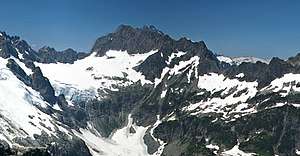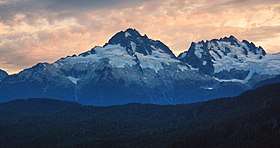Serratus Mountain
Serratus Mountain is a jagged, ridge-like mountain between Mount Tantalus (North) and Lake Lovely Water (South). Like most other peaks in the Tantalus Range, it is composed of loose rock. Most routes here are scrambles. The mountain is a standard single-day destination from the Jim Haberl hut.
| Serratus Mountain | |
|---|---|
 Serratus Mountain seen from Mount Niobe | |
| Highest point | |
| Elevation | 2,321 m (7,615 ft) |
| Prominence | 291 m (955 ft) |
| Coordinates | 49°47′34″N 123°18′7″W |
| Geography | |
 Serratus Mountain Location in British Columbia  Serratus Mountain Serratus Mountain (Canada) | |
| Location | British Columbia, Canada |
| Parent range | Tantalus Range, Coast Mountains |
| Topo map | NTS 92G/14 |
| Climbing | |
| First ascent | 1911 B. Darling; S. Davies; A. Morkill |
| Easiest route | Class 3,4 (scrambling) |
Climate
Based on the Köppen climate classification, Serratus Mountain is located in the marine west coast climate zone of western North America.[1] Most weather fronts originate in the Pacific Ocean, and travel east toward the Coast Mountains where they are forced upward by the range (Orographic lift), causing them to drop their moisture in the form of rain or snowfall. As a result, the Coast Mountains experience high precipitation, especially during the winter months in the form of snowfall. Temperatures can drop below −20 °C with wind chill factors below −30 °C. The months July through September offer the most favorable weather for climbing Serratus.

Nearby
- Mount Tantalus
- Alpha Mountain
- Mount Dione
- Lake Lovely Water
- Jim Haberl hut
References
- Peel, M. C.; Finlayson, B. L. & McMahon, T. A. (2007). "Updated world map of the Köppen−Geiger climate classification". Hydrol. Earth Syst. Sci. 11. ISSN 1027-5606.
External links
- Weather: Mountain Forecast
- "Serratus Mountain". BC Geographical Names.
- "Serratus Mountain". Bivouac.com.
- BC travel info for the Tantalus Range